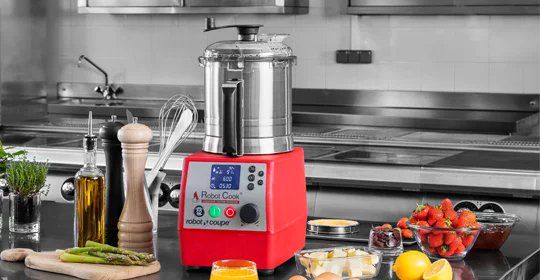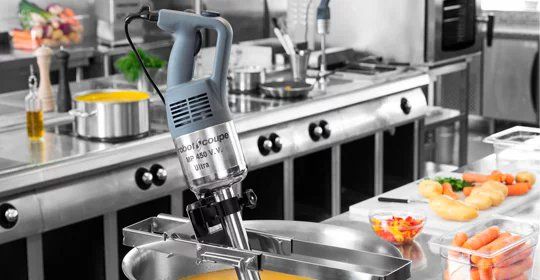Did cooking become more precise or have the tools at our disposal simply changed?

Precision. If you wanted to capture the essence of today’s cooking in just one word, then this would be the word to use. Whether you are serving street food from a seaside shack or scaling the heights of haute cuisine, excellence lies within the detail. Clever flavour combinations and sleight of hand may whet the appetite, but it will be the visceral memory of your silky sauce or crispy crust that lives on. The real detail is in the execution, not the idea.
Yet surely this has always been the case? As chefs we are trained to recognise degrees of doneness by paying attention to sensory cues. Successful apprenticeship hinges on your ability to achieve the same perfect results time and time again. Precision has always been the prize. The price of your labour.
The art of cooking requires us to use our craft to bend ingredients to our will, under a set of constantly changing variables. The science of cooking equips us with the knowledge required to apply this art with greater precision and increased accuracy. But did cooking become more precise, or have the tools at our disposal simply changed?
When food science met gastronomy
The early 1990s saw the beginning of a monumental shift in our understanding and expectations of food. Although cooking has always been a scientific endeavour, the scientific community once dismissed it as a frivolous art. Yet as scientific discovery progresses so too does our understanding, and application, of culinary processes. Which is exactly what happened when food science (the domain of the manufacturers) met with gastronomy (the world of restaurants) and began to share notes.
Their aim was to pool their considerable knowledge towards the ‘application of scientific understanding to the development of new cooking techniques and traditions’. To foster advances in not only the culinary world of the restaurant but in the industrial world of manufacturing too. Their enquiries centred around a set of questions. As a baseline, they examined just how much of the science underlying cooking processes was fully understood. From there they could look at improving existing cooking methods in the light of increased scientific understanding. Of course, there was an element of innovation beyond the reshuffling of classic cuisine. Were there any new ingredients or methods that could improve the quality of the end products? Which processes could be adapted from industrial, large scale operations into the restaurant kitchen?
What began as the often-derided molecular gastronomy, ended up infiltrating the thought processes and techniques of the chefs of today. Molecular cuisine was never intended to be a style of cookery, but a detailed exploration of the science behind cooking processes. By examining the molecular basis of existing classical cuisine, it set the scene for a more precise way of cookery. As well as the ground-breaking experimentation it became famous for.
The birth of precision cooking
From its infancy, the work of chefs such as Ferran Adria and Heston Blumenthal was about exploring the possibilities of ingredients. Pushing the boundaries of taste and texture. If anything, it brought with it a greater respect for produce; not less. It was an intense period of knowledge accumulation. A decade of new understanding that produced more new ideas and recipes than any other. Many, but not all, have been added to our culinary tradition and they inform the food on our plate way beyond high-end cuisine.
In short, the bar was raised.
Food has always been about flavour. It is kind of the point. The layering of flavours within dishes; building depth and creating character. Something that becomes more than the sum of its parts. And we have long understood the impact of texture and the part it plays in shaping those flavours. At the very heart of regional cuisine lies an understanding of how to breathe life into a particular palette of ingredients.
But the question of how to make something taste of more than itself. To capture the very essence of flavour. That was pretty new. The answer seemed to lie in gaining more control over the cooking processes. A gentle handling of ingredients that allowed them to retain their identity yet be thoroughly transformed. To be instantly recognisable yet tantalisingly elusive. Textures of this and something- three-ways may have become a competition cliché, but they revealed a deep interest in the ingredients themselves that once learned could not become unlearned.
It was once thought that cooking beyond the realm of the pâtissier could not be precise. Should not be precise. Art above science and too many variables. We use all our senses, with experience and judgement, to make decisions because situations are rarely the same. Important skills to be retained and nurtured, yet subjective, open to an element of interpretation. Or human error.
Putting the kit in kitchen
The new order reorganised and redefined the workplace. A greater understanding of how ingredients behave at a molecular level, led to a need for more finely calibrated kit. We plundered laboratories and hijacked the kit favoured by scientists. We took powders and potions from the factories of food science. We appropriated appliances from the housewives of Europe.
These shiny new toys came with the promise of possibility, driven by precision and accuracy. Something as simple as a digital probe, once shoved at the back of the drawer for when the EHO paid a visit, now means perfectly en point steaks every service. Items such as the water bath and the Pacojet are now common items of professional kitchen equipment regardless of scope or ambition.
The ability to blend and heat at the same time has changed the way we put food on the plate forever. For a machine to stir, not simply pulverise. A mixer that cooks. To allow for precise application of heat, or speed. Functionality that respects the integrity of ingredients and results in more, not less.
These are the tools we now work with. They have become as much a part of the kitchen landscape as the induction hob or the blast chiller that were also once the new kids on the block. Time marches on and we must keep up or get left behind.
Skill will always be the lynchpin of good cookery. First, catch your monkey. Art, it seems, will not be silenced. Passion and intuition will always be the most powerful tools you possess.
But with the right kit…
Pierre Gagnaire was right; anything is possible.



